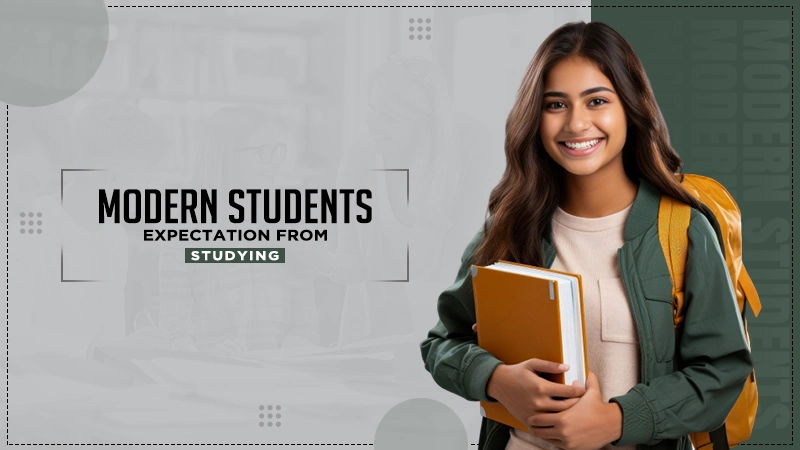
Students graduate from college with a degree, but soon realize they don’t feel ready for the workforce they want. Employers will frequently indicate that new graduates do not present the skills necessary for good job performance. At the same time, student debt continues to climb.

Today’s students no longer view education as simply a means to passing exams or collecting credits. They are looking for something more pragmatic and personal. However, schools that cannot provide answers run the risk of losing credibility.
If educational organizations want to remain relevant, they must consider what the student experience now should be and redesign programs to fit those expectations. So, let’s outline the main priorities that influence how today’s students are thinking about education in this article.
Key Takeaways
- Looking at some affordable choices and clear cost options
- Uncovering the benefits of flexible learning options
- Understanding the metrics of career preparations
- Decoding things beyond critical thinking and prominent social impact
Affordable Choices and Clear Costs
The cost of education is one of the biggest concerns for students and families. Many believe schools don’t explain tuition fees well enough. Students want to know exactly where their money goes and what services they can expect. They also want access to scholarships, financial aid, and affordable program options.
Some students compare programs carefully to find the best value. For example, those studying psychology may search for the cheapest PsyD programs that still provide strong clinical training. This shows that affordability does not mean students want lower quality. Instead, they want schools to respect the financial burden education places on them and offer choices that are both fair and transparent.
Practical Skills That Match the Real World
Students are tired of courses that focus only on theories without showing how to apply them in everyday life. They want an education that prepares them to handle real work challenges. For example, business students look for case studies, simulations, and projects that reflect actual company problems. Engineering students expect labs where they can test and build, rather than simply solving equations on paper.
The shift toward practical learning is also about confidence. When students graduate, they want to walk into their first job already knowing how to use the tools and processes they studied. If their program offers internships, industry projects, or hands-on labs, they feel better prepared. This change in expectation shows that students value practical skills they can measure, not just grades on a transcript.
Flexible Learning Options That Fit Different Lives
Students today juggle many responsibilities. Some work part-time, some care for family, and others balance multiple commitments. Because of this, flexibility is not just convenient—it’s necessary. Online classes, recorded lectures, and hybrid models have become basic expectations. Students also look for programs that allow them to progress at their own pace rather than follow a rigid schedule.
Short courses and micro-credentials are another growing demand. They allow students to pick up specific skills without committing years of time and large amounts of money. Many students combine these smaller learning options with traditional degrees, creating a path that works for their personal and professional goals. This freedom to shape education makes learning more accessible and realistic.
Interesting Facts
A substantial 67% of prospective college students favor the flexibility of attending classes from any location, indicating a strong demand for online and hybrid options.
Career Preparation That Goes Beyond a Degree
A diploma alone is no longer enough for many students. They want career preparation built into their education. This includes internships, networking opportunities, career fairs, and strong connections with employers. They also expect guidance in preparing resumes, practicing interviews, and understanding the job market in their field.
Students are quick to notice when a school’s career services are outdated or disconnected from reality. They want real advice that matches today’s job market, not generic handouts. Programs that work closely with companies and invite professionals to mentor or teach gain trust. Students value education because it not only provides knowledge but also allows them to confidently take the first steps in their chosen career.
Global Perspectives That Broaden Horizons
Students recognize that the world is more connected than ever. They want education that reflects this reality. Many look for opportunities to interact with peers from other countries, whether through exchange programs, international internships, or virtual global classrooms. Exposure to different cultures and viewpoints is not just enriching—it’s a skill that helps in today’s workforce.
Even when travel is not possible, students value courses that include diverse case studies and global issues. For example, discussing climate change, migration, or global health provides a broader context for their learning. Schools that bring in international faculty or collaborate with institutions abroad also meet this growing demand. Students see global awareness as preparation for both professional and personal growth.
Critical Thinking Beyond Grades
Grades still matter, but many students see them as only one measure of success. They want education that encourages them to analyze, question, and problem-solve rather than focus only on memorization. Critical thinking prepares them to adapt to new jobs and industries, particularly as technology and markets change rapidly.
Students value assignments that make them apply knowledge instead of repeating it. Group discussions, debates, and open-ended projects give them space to test ideas. They also appreciate teachers who reward creativity and effort, not just correct answers. Education that develops critical thinking helps students face challenges more confidently after graduation.
Social Impact That Feels Meaningful
Students today often ask how their studies can contribute to society. They are motivated by purpose as much as by paychecks. Many look for programs that highlight sustainability, community involvement, or social justice. Service-learning projects, volunteer opportunities, and research tied to real problems give them a sense that their education matters beyond personal gain.
For example, nursing students may want training in underserved communities, while engineering students may prefer projects that solve environmental issues. This demand shows that students care about the wider effect of their work. Schools that connect education with positive social outcomes meet this expectation and stand out to prospective learners.
Students are making their voices heard, so education is changing. They want practical skills, adaptable options, and assistance that goes beyond academics. They also expect teachers who connect with them, programs that prepare them for real jobs, and technology that adds value rather than confusion. On top of this, they look for meaning—whether through global experiences, critical thinking, or contributing to society.
These expectations are not unreasonable. They reflect a generation that sees education as an investment in their future and demands a fair return. Schools that listen and adapt to these needs will not only attract students but also prepare graduates who are capable, confident, and ready for the challenges ahead.
Ans: The modern view of education primarily focuses on the holistic approaches that boost the creativity of young minds and enhance their problem-solving abilities.
Ans: The major difference lies in the teacher’s role, learning methodologies (memorization vs. application), curriculum flexibility (fixed vs. dynamic), and the integration of technology (limited vs. extensive).
Ans: The 1 3 7 Rule in studying refers to a Spaced Repetition method for long-term memory retention.